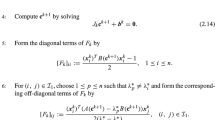Abstract
A Gauss-Newton-like method for solving singular nonlinear equations is presented. The local convergence analysis shows that this method converges quadratically. The algorithm requires second derivative information in the formF″ ab only, which makes it attractive from the viewpoint of computational effort.
Zusammenfassung
Ein Gauß-Newton-ähnliches Verfahren zur Lösung singulärer nichtlinearer Gleichungssysteme wird vorgestellt. Die Konvergenzanalyse zeigt, daß das Verfahren lokal quadratisch konvergiert. Der Algorithmus ist effektiv, implementierbar, da die von ihm benötigten Informationen 2. Ordnung nur in der GestaltF″ ab vorkommen.
Similar content being viewed by others
References
Griewank, A.: On solving nonlinear equations with simple singularities or nearly singular solutions. SIAM Review27, 537–563 (1985).
Menzel, R., Pönisch, G.: A quadratically convergent method for computing simple singular roots and its application to determining simple bifurcation points. Computing32, 127–138 (1984).
Weber, H., Werner W.: On the accurate determination of nonisolated solutions of nonlinear equations. Computing26, 315–326 (1981).
Tapia, R. A.: Quasi-Newton methods for equality constrained optimization: Equivalence of existing methods and a new implementation. In: Nonlinear programming 3 (Mangasarian, O., Meyer, R., Robinson, S., eds.), pp. 125–164. New York: Academic Press 1978.
Boggs, P. T., Tolle, J. W., Wang, P.: On the local convergence of quasi-Newton methods for constrained optimization. SIAM J. Control. Optim.20, 161–171 (1982).
Nocedal, J., Overton, M. L.: Projected Hessian updating algorithms for nonlinearly constrained optimization. SIAM J. Numer. Anal.22, 821–850 (1985).
Pönisch, G., Schwetlick, H.: Computing turning points of curves implicitly defined by nonlinear equations depending on a parameter. Computing26, 107–121 (1981).
Hoy, A.: A relation between Newton and Gauss-Newton steps for singular nonlinear equations. Computing40, 19–27 (1988).
Schwetlick, H.: Numerische Lösung nichtlinearer Gleichungen. Berlin: VEB Deutscher Verlag der Wissenschaften 1979.
Griewank, A., Osborne, M. R.: Analysis of Newton's method at irregular singularities. SIAM J. Numer. Anal.20, 747–773 (1983).
Hoy, A.: Analysis of a bordering approach for solving singular nonlinear equations. To appear in Wiss. Z. d. Martin-Luther-Univ. Halle-Wittenberg 1989.
Peters, G., Wilkinson, J. H.: Inverse iteration, ill-conditioned equations and Newton's method. SIAM Review21, 339–360 (1979).
Reddien, G. W.: On Newton's method for singular problems. SIAM J. Numer. Anal.15, 993–996 (1978).
Rall, L. B.: Convergence of the Newton process to multiple solutions. Numer. Math.9, 23–37 (1966).
Author information
Authors and Affiliations
Rights and permissions
About this article
Cite this article
Hoy, A. An efficiently implementable Gauss-Newton-like method for solving singular nonlinear equations. Computing 41, 107–122 (1989). https://doi.org/10.1007/BF02238733
Received:
Revised:
Issue Date:
DOI: https://doi.org/10.1007/BF02238733




